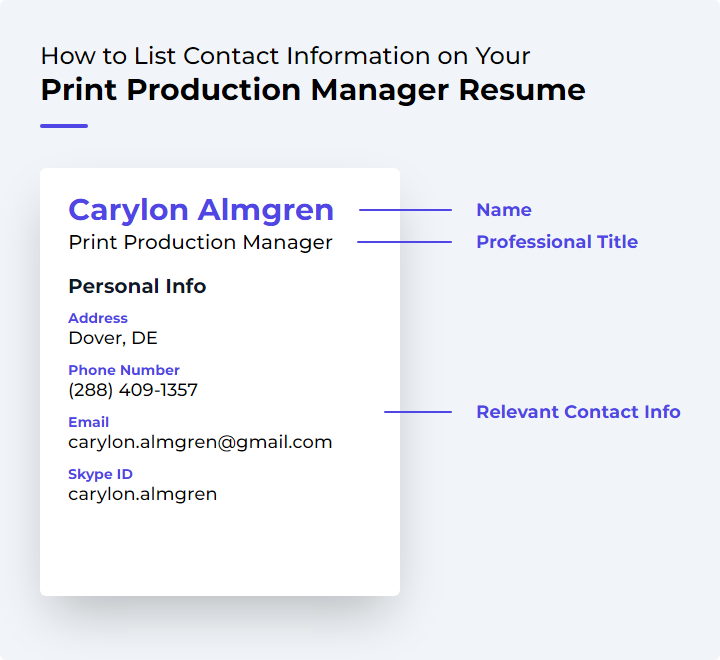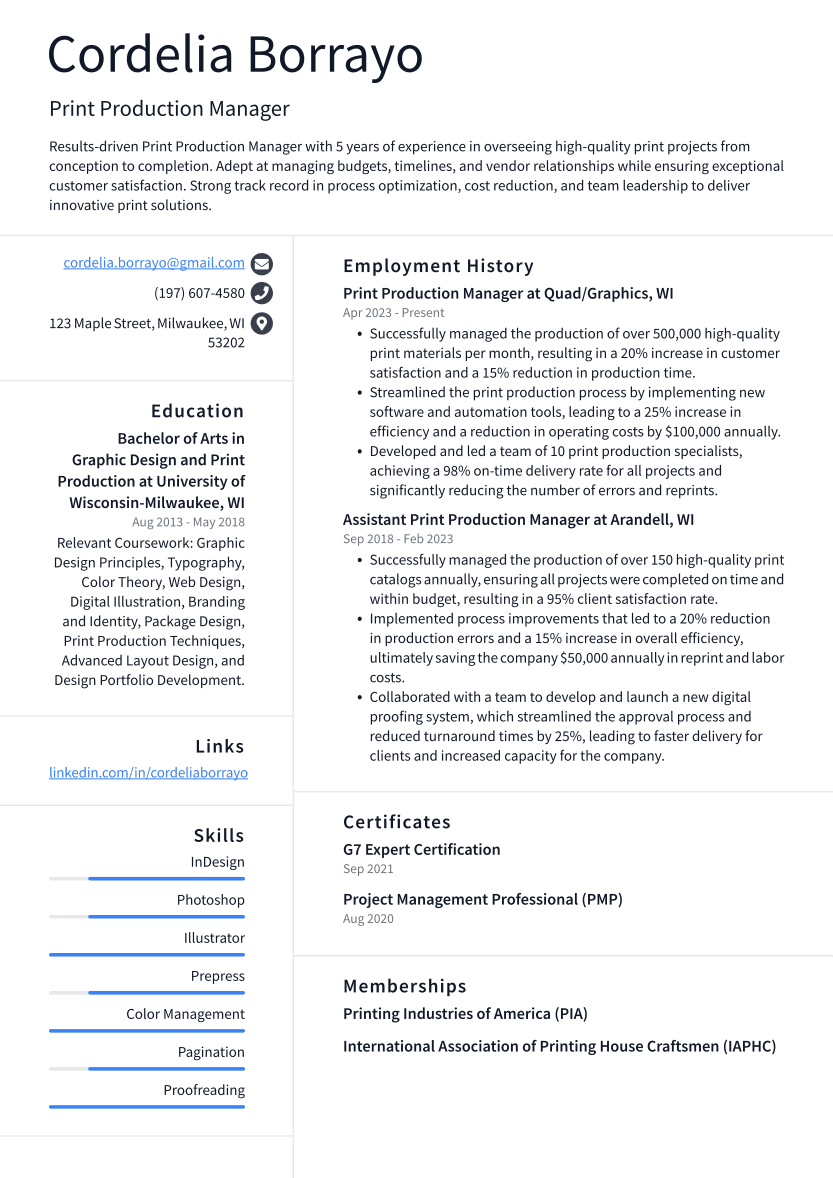Print Production Manager Resume Examples
Writing a great print production manager resume is important because it is one of the first things a potential employer will see when they are considering you for a position. It is your opportunity to make a good first impression and sell yourself as the best candidate for the job.
Create your resume
Select from 7 professional resume templates
If you're looking for inspiration when it comes to drafting your own print production manager resume, look no further than the samples below. These resumes will help you highlight your experience and qualifications in the most effective way possible, giving you the best chance of landing the print production manager job you're after.
Essential Components of a Print Production Manager's Resume
A Print Production Manager's resume is a critical document that showcases your expertise and qualifications in overseeing the entire print production process. It's essential to highlight your experience with budget management, team coordination, quality control, and adherence to deadlines. Understanding the significance of each resume section and optimizing them to stand out is crucial. The following sections will delve into these aspects, providing guidance on how to construct a compelling resume that captures the attention of potential employers.
1. Contact Information
Ensuring your contact information is accurate and professional is paramount—it's the first thing employers will notice and use to initiate contact.

Place your contact details prominently at the top of your resume, including your full name, phone number, email address, and LinkedIn profile if applicable. While a home address is optional, ensure your email address is professional, and your phone number includes the appropriate area codes for international job searches.
- Professional email addresses are a must; use a combination of your first and last name.
- Include a country code with your phone number if applying for jobs abroad.
- A LinkedIn profile link can provide additional insight into your professional background, but ensure it aligns with your resume content.
Double-check this section for accuracy to avoid missing potential job opportunities.
2. Professional Summary
The professional summary is a succinct yet impactful overview of your career highlights, including your most relevant skills, experiences, and achievements. Tailor this section to the position you're applying for, emphasizing your proficiency in managing print production, leading teams, ensuring quality, and meeting deadlines.
For example: "Detail-oriented Print Production Manager with over ten years of experience in large-scale project management, cost reduction through efficient production, and vendor negotiations. Skilled in leading diverse teams to deliver exceptional products on schedule."
This section is your opportunity to make a strong first impression, so focus on what you can offer to the prospective employer.
3. Work Experience
Your work experience section is a chronological showcase of your professional journey, highlighting your roles, responsibilities, and accomplishments.
List your positions in reverse chronological order, detailing your job title, employer, dates of employment, and a brief description of your duties and successes. Emphasize skills such as project management, print production expertise, vendor relations, quality control, and budgeting.
For example:
- Print Production Manager | ABC Printing Company | Jan 2015 - Present
- Directed a team of 10, achieving high-quality print materials within tight deadlines.
- Implemented quality control measures, reducing errors by 20%.
- Negotiated with suppliers to ensure timely delivery and reduced costs by 15%.
- Assistant Print Production Manager | XYZ Printing Solutions | May 2010 - Dec 2014
- Assisted in managing daily operations, including scheduling and staff oversight.
- Contributed to the adoption of new digital printing technology, increasing productivity by 30%.
Use action verbs and quantify achievements to demonstrate your effectiveness. Align this section with the job description, focusing on the most relevant experiences.
4. Skills and Competencies
The "Skills and Competencies" section is where you highlight your technical and soft skills pertinent to the role of a Print Production Manager.
- Technical Skills: Proficiency in print production processes, software expertise (e.g., Adobe Creative Suite, QuarkXPress), and knowledge of materials and color theory are essential.
- Project Management Skills: Demonstrating the ability to manage multiple projects, adhere to deadlines, and maintain quality control is crucial.
- Communication Skills: Effective communication with clients, suppliers, and team members is key to smooth operations.
- Leadership Skills: The ability to motivate and manage a team is vital for a managerial role.
- Attention to Detail: Precision is critical to avoid costly errors in print production.
- Problem-Solving Skills: Quick resolution of production issues is necessary to minimize delays.
- Negotiation Skills: Effective negotiation with vendors can lead to cost savings without compromising quality.
- Safety Standards Knowledge: Awareness of safety protocols ensures a secure working environment.
Customize this section to reflect the specific skills required by the job posting.
Related: Print Production Manager Skills: Definition and Examples
5. Education and Certifications
Education and certifications validate your knowledge and skills in print production management.
- Education: A bachelor's degree in a relevant field is typically required, providing foundational knowledge in printing, design, and technology.
- Certifications: While not always mandatory, certifications (e.g., CGCM, CPPP, ACE) can enhance your resume by demonstrating a commitment to professional development.
- Continuing Education: Ongoing learning is important in a rapidly evolving field, so include any relevant courses or workshops.
- Technical Training: Training in print machinery operation, prepress procedures, and quality control is advantageous.
List your educational background in reverse chronological order, including institutions, dates, degrees, and majors. For certifications, include the issuing organization, name of the certification, and date obtained.
Highlighting relevant education and certifications can distinguish you from other candidates and demonstrate your dedication to the field.
Related: Print Production Manager Certifications
6. Achievements and Awards
The "Achievements and Awards" section showcases your accomplishments and recognition in the print production industry, providing tangible evidence of your expertise and commitment to excellence.
Include any awards or commendations received, such as "Employee of the Month" or industry-specific honors like "Print Production Manager of the Year." Highlight successful projects that resulted in cost savings, process improvements, or quality enhancements.
- Leadership achievements, such as effectively managing large teams or implementing new training initiatives, are also worth mentioning.
- Innovations that significantly increased productivity or reduced expenses should be highlighted.
Be specific about your accomplishments, using quantifiable data where possible, to demonstrate your impact.
An "Achievements and Awards" section can set you apart from other candidates by illustrating your results-driven approach and continuous pursuit of excellence.
7. References
The "References" section can be a valuable addition to your resume, allowing potential employers to verify your professional abilities and character through interactions with your previous colleagues.
While some opt for "references available upon request," providing them upfront can expedite the hiring process and show preparedness.
- Obtain consent from each reference before listing them.
- Include their full names, current job titles, companies, contact numbers, and professional email addresses.
- Briefly describe your relationship with each reference (e.g., "Former supervisor at XYZ Company").
Inform your references about the positions you're applying for so they can tailor their recommendations accordingly.
Although the "References" section may seem less critical than "Experience" or "Skills," it can significantly bolster your candidacy by providing credible endorsements of your capabilities as a Print Production Manager.
